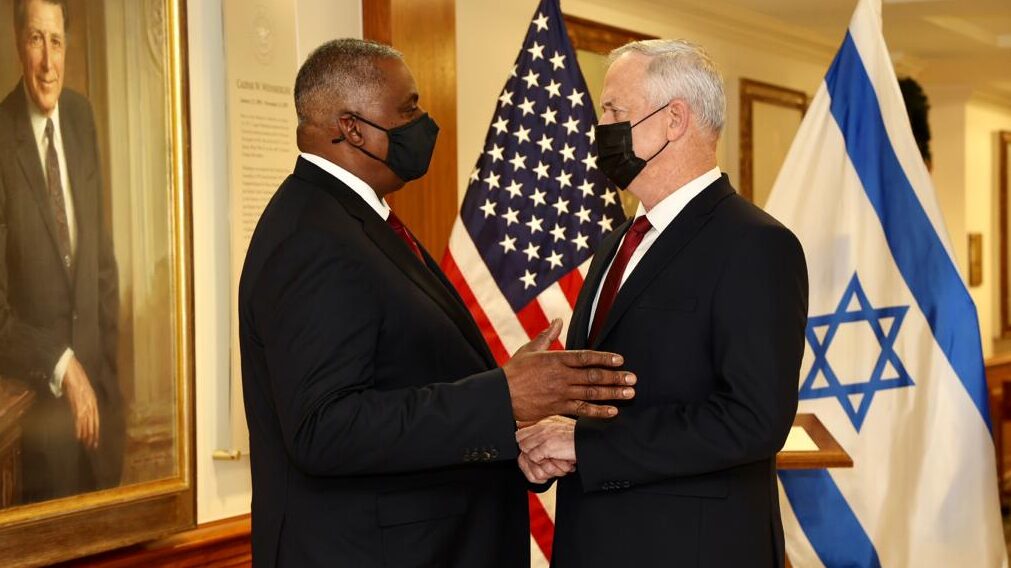
US Defense Secretary Lloyd Austin and Israeli Minsiter of Defense Benny Gantz meet at the Pentagon. (Shmulik Almany/IMOD)
TEL AVIV: With Israeli Minister of Defense Benny Gantz in Washington today for meetings with American officials about Iran and talks about a new nuclear agreement seemingly on the rocks, Israeli military planners are taking a realistic look at the holes in their war plans and hoping to find supplemental capabilities from the US.
While stressing that no decision has been made about military strikes, Israeli defense sources tell Breaking Defense that they are hopeful American mid-air refueling capabilities can be secured in case ongoing nuclear talks with Iran break down for good and Israel feels forced to take military action.
With Israeli Minister of Defense Benny Gantz and Mossad head David Barnea in Washington today for meetings with American officials about Iran, and the talks about a new nuclear agreement seemingly on the rocks, Israeli military planners are taking a realistic look at the holes in their war plans and hoping to find supplemental capabilities from the US.
While in the past Israel has executed a series of espionage efforts against Iranian nuclear scientists — media reports alleged a high volume of such operations during the administration of former government of Benjamin Netanyahu — it has not stopped Iran’s movement towards nuclear capabilities, and the current government wants to be ready in case military action is needed. Israeli experts now allege Iran is only months away from having the capability to build a nuclear bomb.
Sources here described new intelligence reports being presented to US officials, including to Defense Secretary Lloyd Austin, as “very detailed” and “convincing” about Iran’s intention to achieve a nuclear weapon that can pair with its growing ballistic missile capability, now believed to have a range of 1,200 km. However, actual war plans were not expected to be presented at the meeting.
Reuters reported that today’s meeting between Gantz and Austin would include discussions about military exercises the US and Israel could do to prepare for potential conflict.
In a tweet, Gantz said of the meeting that the two sides “reviewed shared strategic challenges with an emphasis on the Iranian nuclear threat and the need to deepen our dialogue and cooperation, including on topics of military readiness to stop and face Iran’s regional aggression.” A Pentagon statement reads that Austin “confirmed U.S. resolve to prevent Iran from obtaining a nuclear weapon” and says the two men “discussed shared concerns regarding Iran’s nuclear provocations, support for terrorism, and missile program.”
Needed Assistance
The sources said that Israel is realistic that a strike against Iranian nuclear capabilities would require not just a political “green light ” from Washington, but essential help in the form of aerial refueling capabilities from the US. (While Israel has other, more complicated options for how to pull off a strike, getting American refueling support is viewed as the best way forward.)
Israel has a fleet of old 707 refuelers, but the country plans to procure the Boeing KC-46A as an updated option, with plans to have the first two KC-46As on contract by mid-2022.
However, a few weeks ago, the Israeli Air Force amended its original Letter of Acceptance (LOA) for the KC-46 and now is asking for an “emergency delivery” of four aircraft through the process of “tail swapping,” where production slots of aircraft purchased by the US would instead be delivered to the IAF.
RELATED: Israel, US step up direct actions against Iranian drone production
With a potential strike in Iran always going to be dependent on refueling capabilities, why was the emergency request made only recently? A defense source pointed the finger at the Israeli Ministry of Defense, saying the MoD was too slow in making an official request for the aircraft to be sped up. “The process took three times the time it should have taken,” the defense source said. (The Israeli ministry of defense declined to comment.)
In addition to tanking assistance, Israel is seeking protective help as well. Israeli planners are hopeful that the Pentagon would be willing to deploy THAAD batteries in the area to supplement Israel’s domestic Arrow interceptors, should conflict with Iran become a reality.
Israel would also like the US to supply heavy munitions capable of getting at the Iranian bunkers where much of the nuclear program is believed to be protected. As with the refueling, Israel has other options, sources say, but view US weapons as the easiest path forward.
Practice for a potential joint operation against Iran may have already happened, in plain sight.
In October, Israel hosted the Blue Flag exercise, which officially featured the air forces of Israeli, the US, Germany, Italy, Britain, France, India and Greece. That came on the heels of joint exercises between the Israeli Navy and the US Navy’s Fifth Fleet in September.
Most notably, the UAE sent a top-level commander to the event, and according to unauthorized photos, the Jordanian Air Force took part in the event as well — hinting as greater ties between Israel and its neighbors, who are united in opposition to Iran. Israeli sources believe Blue Flag, along with the naval exercises, served as an introduction to how joint operations could occur should Israel decide to act.
Move over FARA: General Atomics pitching new Gray Eagle version for armed scout mission
General Atomics will also showcase its Mojave demonstrator for the first time during the Army Aviation Association of America conference in Denver, a company spokesman said.


























